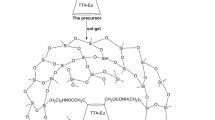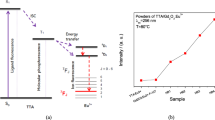Abstract
A novel ternary molecular hybrid material has been obtained by immobilization of Eu-Salen complex into silica matrix and poly (methyl methacrylate) (PMMA) matrix. Here, the Salen-type Schiff-base ligand H2Salen (N,N′-bis(salicylidene)ethylenediamine) which has been successfully modified by 3-(triethoxysilyl)-propyl isocyanate (TESPIC) has been used as a flexible linker and the antenna. The obtained solid hybrid material shows not only the characteristic red emission of Eu3+ but also the blue emission of Salen-Si host arising from the inefficient energy transfer from antenna to Eu3+, leading to the unexpected near-white light color of the material. For comparison, the binary hybrid without PMMA has also been prepared. Photoluminescent spectra suggest that the introduction of PMMA can enhance the emission intensity whereas the chromaticity nearly has not been changed. Moreover, thermal analysis has revealed the good thermal stability of the ternary hybrid material. X-ray diffraction patterns demonstrate the amorphous structure of both hybrid materials.






Similar content being viewed by others
References
M. Rajendran, E. Yapici, L.W. Miller, Lanthanide-based imaging of protein–protein interactions in live cells. Inorg. Chem. 53, 1839–1853 (2014)
A.P. Bassett, S.W. Magennis, P.B. Glover, D.J. Lewis, N. Spencer, S. Parsons, R.M. Williams, L. De Cola, Z. Pikramenou, Highly luminescent, triple- and quadruple-stranded, dinuclear Eu, Nd, and Sm(III) lanthanide complexes based on bis-diketonate ligands. J. Am. Chem. Soc. 126, 9413–9424 (2004)
S. Capecchi, O. Renault, D.G. Moon, M. Halim, M. Etchells, P.J. Dobson, O.V. Salata, V. Christou, High-efficiency organic electroluminescent devices using an organoterbium emitter. Adv. Mater. 12, 1591–1594 (2000)
G.F. de Sá, O.L. Malta, C. de Mello Donegá, A.M. Simas, R.L. Longo, P.A. Santa-Cruz, E.F. Da Silva Jr., Spectroscopic properties and design of highly luminescent lanthanide coordination complexes. Coord. Chem. Rev. 196, 165–195 (2000)
Y. Li, B. Yan, H. Yang, Construction, characterization and photoluminescence of mesoporous hybrids containing europium(III) complexes covalently bonded to SBA-15 directly functionalized by modified β-diketone. J. Phys. Chem. C 112, 3959–3968 (2008)
B. Yan, Recent progress in photofunctional lanthanide hybrid materials. RSC Adv. 2, 9304–9324 (2012)
L.D. Carlos, R.A. Ferreira, V. Bermudez, S.J. Ribeiro, Lanthanide-containing light-emitting organic–inorganic hybrids: a bet on the future. Adv. Mater. 21, 509–534 (2009)
K. Binnemans, Lanthanide-based luminescent hybrid materials. Chem. Rev. 109, 4283–4374 (2009)
X. Zou, M. Li, P. Yan, J. Zhang, G. Hou, G. Li, Systematic study on the structures of salen type lanthanide complexes tuned by lanthanide contraction and corresponding luminescence. Dalton Trans. 42, 9482–9489 (2013)
K. Sheng, B. Yan, Coordination bonding assembly and photophysical properties of europium organic/inorganic/polymeric hybrid materials. J. Photochem. Photobiol. A 206, 140–147 (2009)
Y. Li, J. Wang, W. Chain, X. Wang, Z. Jin, X. Li, Coordination assembly and characterization of europium(III) complexes covalently bonded to SBA-15 directly functionalized by modified polymer. RSC Adv. 3, 14057–14065 (2013)
X.F. Qiao, B. Yan, Hybrid materials of lanthanide centers/functionalized 2-thenoyltrifluoroacetone/silicon–oxygen network/polymeric chain: coordination bonded assembly, physical characterization, and photoluminescence. Inorg. Chem. 48, 4714–4723 (2009)
K. Sheng, B. Yan, H.-F. Lu, L. Guo, Ternary rare earth inorganic–organic hybrids with a mercapto-functionalized Si–O linkage and a polymer chain: coordination bonding assembly and luminescence. Eur. J. Inorg. Chem. 2010, 3498–3505 (2010)
K. Lunstroot, K. Driesen, P. Nockemann, L. Viau, P.H. Mutin, A. Vioux, K. Binnemans, Ionic liquid as plasticizer for europium(III)-doped luminescent poly(methyl methacrylate) films. Phys. Chem. Chem. Phys. 12, 1879 (2010)
S. Biju, Y.K. Eom, J.-C.G. Bünzli, H.K. Kim, A new tetrakis β-diketone ligand for NIR emitting LnIII ions: luminescent doped PMMA films and flexible resins for advanced photonic applications. J. Mater. Chem. C 1, 6935–6944 (2013)
K. Sheng, B. Yan, A new luminescent molecular based terbium hybrid material containing both organic polymeric chains and inorganic silica networks. J. Mater. Sci. Mater. Electron. 21, 65–71 (2010)
B. Yan, Y.J. Gu, A novel white-luminescent ternary europium hybrids with phenanthroline functionalized periodic mesoporous organosilicas (PMOs) and 2-methyl-9-hydroxyphenalenone. Inorg. Chem. Commun. 34, 75–78 (2013)
V. Divya, S. Biju, R.L. Varma, M.L.P. Reddy, Highly efficient visible light sensitized red emission from europium tris[1-(4-biphenoyl)-3-(2-fluoroyl)propanedione](1,10-phenanthroline) complex grafted on silica nanoparticles. J. Mater. Chem. 20, 5220–5227 (2010)
Acknowledgments
This work was supported by the National Natural Science Foundation of China (21101107), the Science Foundation for the Excellent Youth Scholars of Shanghai Municipal Education Commission (Slg10031) and the innovation Fund of Shanghai (SH1110252164).
Author information
Authors and Affiliations
Corresponding authors
Rights and permissions
About this article
Cite this article
Sheng, K., Li, HT., Jin, Z. et al. Near-white light luminescent material from Eu(III) complexes encapsulated in silica/PMMA matrices. J Mater Sci: Mater Electron 25, 4562–4567 (2014). https://doi.org/10.1007/s10854-014-2204-8
Received:
Accepted:
Published:
Issue Date:
DOI: https://doi.org/10.1007/s10854-014-2204-8




